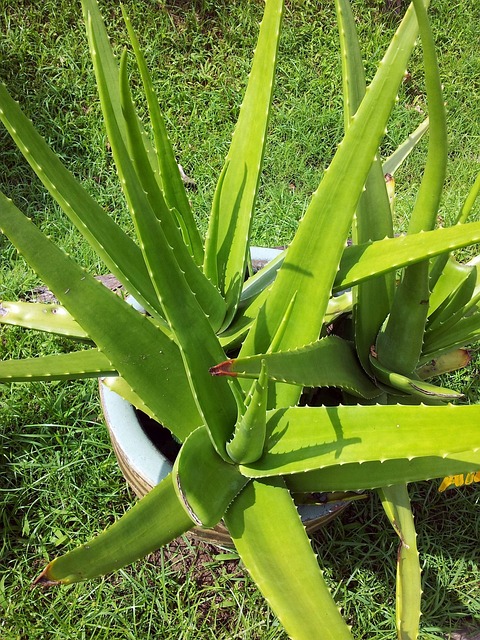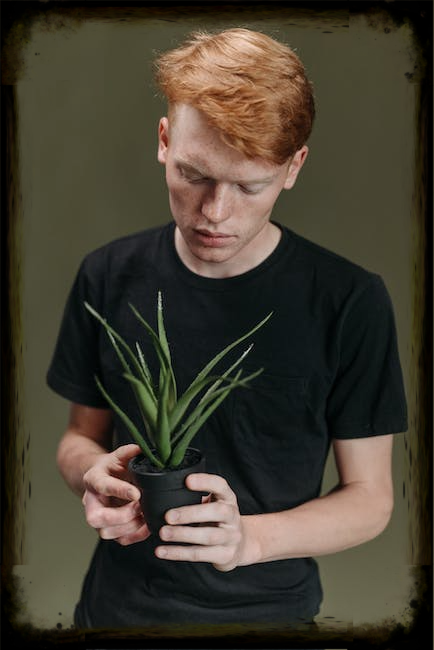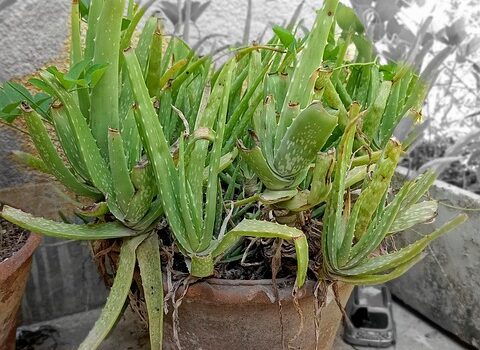Why is My Aloe Vera Plant Turning Red?
The Aloe Vera plant is a popular succulent known for its many health benefits. It is commonly used in skincare products, as well as for its medicinal properties. This miracle plant has also been used to treat fungal infections and other skin problems. However, sometimes Aloe Vera plants can turn red, which can be a cause for concern for plant owners. In this article, we will discuss the natural and unnatural causes of Aloe Vera turning red, as well as provide tips on how to fix the issue.
Here we will address some of the most common reasons your Aloe Vera loses its green color, starts showing red tints and the aloe’s leaves turn different colors. We are mostly concerned with those red edges or red coloration you see in the aloe leaves. OK, the leaves of the plant look like fat appendages, but they really are leaves.

- Overwatering
Overwatering an aloe vera plant is another common problem and may be key contributor to its reddening. Aloe vera, being a succulent that prefers dry climates, should only receive moisture at its roots without becoming soggy; overwatering could also damage leaves and stems as well as lead to its roots becoming waterlogged. Waterlogged plants can result in fungal diseases or mold growth. Aloe Vera plants require well-draining soil mix for maximum drainage, only needing to be watered when the soil feels nearly dry to the touch.
One of the best way to avoid overwatering your plant is to make sure its pot size is appropriate. Its roots expand as it grows, an over-sized pot could make draining too much excess water difficult – try switching to terracotta pots as they allow soil drainage more effectively. Terracotta pots or colorful Mexican Talavera pots really look good with a healthy green Aloe Vera plant in them.
Also avoid placing aloe plants in drafty locations that could result in the opposite problem of loss of moisture that would harm the plant. Improper watering and low light will mess up the roots and the rest of the plant. I know this all sound hard, but in no time you will be an aloe pro.
You have to give Aloe Vera enough water, proper care, warm weather and you will have a beautiful plant.
- Sunburn
Aloe plants that have been cared for properly will occasionally turn red as they thrive; this should not be taken as an alarm that something is amiss with it; usually this change is due to stress response caused by strong sunlight or heat and will return back green once corrected.
Aloe plants can be extremely sensitive to sunlight and overexposure can result in too much sunlight and sunburn. To avoid sunburn avoid direct sunlight. Using less water to allow the soil to dry out completely before watering again should help avoid fungal spots and diseases that could turn your aloe vera leaves yellow or red.
Indoor or outdoor, an aloe vera plant’s leaves turning red can indicate that they’ve received enough sunlight and heat to thrive, but keep an eye out for any drooping leaves which might indicate too much sunshine.
If the leaves on your aloe plant are drooping and turning yellow or brown, it could be because the plant is receiving too much direct sunlight. To remedy this situation, try moving it into more shaded locations to ensure that sunlight doesn’t hit directly onto its leaves. You can gradually increase the plants exposure to more sunlight as it adapts.
If your aloe plant is exposed to too much sun and heat, try installing a green shading net outdoors or hanging one inside on your window sill as a protective measure.
Aloe Vera plants that suddenly have red leaves could also be suffering from overly sandy soil, which can wreak havoc with their roots and burn them. Seems counterintuitive for a desert plant, but you have to have a somewhat moisture-retaining mix that will drain well in case of excess watering. To remedy this problem, add some compost to your sandy soil or repot your aloe vera plant with quality cacti/succulent soil which has adequate drainage capabilities.
Your aloe may also become red if its leaves become dead or diseased, which could be caused by overwatering and poor drainage. To remedy this, remove any dead leaves and only water it if the top two to three inches of soil have dried out completely. In the beginning, stick your finger in the soil to check how wet it is. With practice, you will be able to just look at the soil surface and judge the moisture content.
Temperature should also be taken into consideration; ideal spot should range between warm and not-too-hot in your room where your plant resides. Avoid cold temperatures.
Repotting an aloe plant will likely cause it to be unsettled for several days as its roots adapt to their new conditions, turning red as it adjusts. You can help by placing it in a warmer location with some partial shade during this transitional phase.
Your aloe may have outgrown its pot, causing it to lean or fall over. Repotting will allow its roots to strengthen further and the plant can stand upright more securely; just be careful that you only do it when it is necessary as too early transplanting could harm its roots.
- Insects
Aloes are generally easy to care for, yet as with any plant they can still be susceptible to insect problems. Mealybugs (white cottony insects) and scale are two of the most frequently occurring insect problems that target succulents. Both these sap suckers target succulent leaves and stems by penetrating cellular membranes to extract essential nutrients, ultimately leaving an aloe vulnerable and at risk. Left unchecked these pests can cause irreparable damage that requires immediate action to resolve. You can spray your aloe with rubbing alcohol to get rid of these pest. Avoid direct sunlight on the plant immediately after spraying to keep from burning your aloe vera.
- Disease
Aloe plants can also become susceptible to diseases that threaten its leaves, such as rust. When infected aloes become infected they can develop black or brown circular spots on their leaves called rust which form when their outer leaf layers oxidize, breaking down and turning dark; eventually this rot spreads further up their stem and can eventually kill off their entire plant.
Other illnesses that can turn the leaves of an aloe vera plant red include fusarium wilt or Phytophthora cinnamomifolia bacteria infections that cause red or purple spots on leaves and tissue rotting; additionally they produce toxic slimy black liquid that kills off plants quickly.
If your aloe vera become diseased, throw the whole thing out, soil and all so you don’t infect and kill off any other plants. Wash the pot and let it sit in direct sunlight for a few days before replanting in it.

- Stress
An aloe plant under stress due to changes in its environment may turn colors other than green and lose leaves, prompting us to quickly identify its source so it can recover as soon as possible. If your aloe is turning red, there are a few steps that could help it recover more quickly.
Aloes may turn red if they experience sudden fluctuations in soil water concentration, for instance by shifting from outdoor pot to an indoor sunnier location and suffering a rapid drop in water concentration which damages their cells. A slow-release fertilizer could help alleviate this problem or repotting into larger container with fast-draining soil can provide relief; soft stem fleshy plants like aloes are susceptible to sudden shifts as their leaves and stem store moisture, and any sudden change can make the plant wilt and turn red as it attempts to restore equilibrium between soil water content and atmospheric conditions.
One common cause of an aloe plant turning red is overwatering, as too much moisture seeps up through its roots, leading to soggy and rotted plants. To avoid overwatering your aloe plant, use a pot that drains well and only water when soil moisture levels decrease – this will allow for optimal soil conditions for plant growth.
Change in its environment is another common reason an aloe plant might turn red, including being transported from hot, sunny outdoor conditions into cooler indoor ones, which may result in discoloration at first but usually resolves once the plant adjusts to its new conditions.
Aloe plants often turn red due to insufficient sunlight. Aloes require at least several hours of sunshine each day in order to thrive, preferring an area where its rays reach every leaf. When aloes don’t receive enough light they become leggy and stretched towards their light source – in these instances try moving it somewhere where it receives more direct light if that occurs.
Remember the aloe vera likes warm temperatures and not cold weather. Although it is a dry climate plant it does not like too much light and if it is really hot indirect sunlight is preferred.
An aloe experiencing stress due to being repotted or other changes may show signs of turning red, which is a natural reaction and will recover once adjusted to its new environment. When reppotting an aloe plant make sure not to increase pot size by more than one and use fast-draining potting mix.
If your aloe has soft rot, which is caused by bacteria thriving in warm and damp conditions, it’s probably too late for saving it. But if your plant still has healthy roots at its base, cuttings from above the soft rot could potentially be taken and planted into pots to grow new roots and rescue its life.
To prevent soft rot, be sure to regularly remove dead leaves that fall from your aloe plant and clean its roots using a garden hose. Additionally, if your aloe shows any sign of soft rot, stop watering it immediately and allow its soil to completely dry out. Be sure the soil has dried out a bit before beginning again. Too much water will water log the plant. You want to mimic its natural cycle in nature and keep it in a healthy ecosystem functioning optimally.

- Fertilizer
Aloe vera plants require very minimal fertilizer application; in general, specialized succulent and cacti fertilizers will do just fine in spring. Avoid general plant fertilizers which could potentially create too much nitrogen build-up. Also, if you can, use an organic fertilizer as it is easier on the plant. It is best to fertilize during the growing season in spring and summer and avoid fall and winter treatment. Be careful about heavy application of fertilzer as this can cause root rot as well as lead to color change in the leaves.
Overfertilization is another issue that can be remedied by decreasing the amount of fertilizer you apply – this will enable the plant to store up its own nutrients instead of losing them through soil drainage.
Too much fertilizer may also contribute to aloe vera plants turning red, as aloes thrive best in soil with very light nutrients and low nitrogen content. Regular plant fertilizer with too much nitrogen could damage their root system; to remedy this situation, use a special “succulent and cacti” fertilizer available from garden centers or online.
